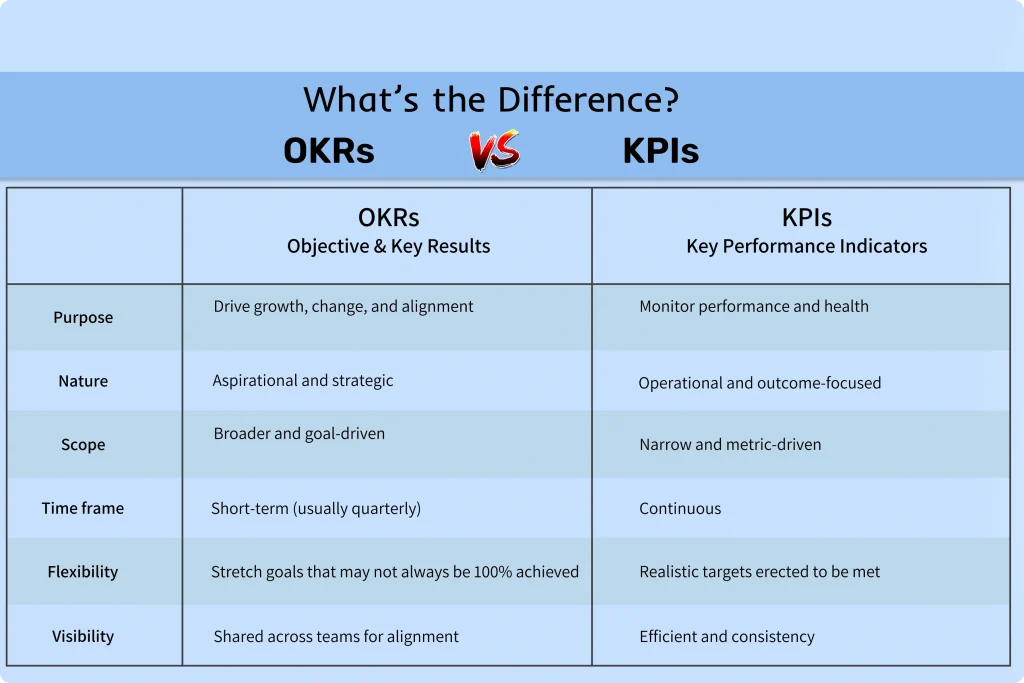OKRs vs. KPIs: Which Drives Better Results?
OKRs (Objectives and Key Results) and KPIs (Key Performance Indicators) are the two popular frameworks that dominate the goal-setting conversation. While both aim to enhance focus, accountability, and outcomes, their purpose and application vary. OKRs are aspirational, designed to push teams beyond routine performance by aligning them around ambitious, measurable objectives. KPIs, on the other hand, focus on tracking steady, operational performance through specific metrics. Understanding the difference and knowing when to use each is key to driving meaningful results.

What Are OKRs?
OKRs (Objectives and Key Results) are an effective goal-setting system that helps teams focus on the most measurable, strong results. They are composed of an explicit, qualitative objective of what you would like to accomplish and results that can be quantifiable and specific. used to measure progress towards the goal. This approach helps teams set goals but remain grounded in the data-driven outcomes.
For example, your aim is to improve the team’s engagement via remote then your goal would be only that. The most important results could be steps like arranging three virtual team-building activities and establishing a weekly check-in meeting to ensure everyone is connected and obtaining feedback from employees via HajirHR surveys. These specific steps can help track how the team is progressing and make sure that it is on the right track to improve engagement.
What Are KPIs?
KPIs (Key Performance Indicators) are quantifiable numbers that allow organizations to track the performance of their business over time. They are a clear way to measure how certain processes or tasks are performing. The most common examples are monthly sales revenue as well as the rate of customer churn as well as the conversion rate for websites and the rate of employee turnover. These indicators provide teams with an overview of their performance and assist in identifying areas that need to be addressed.
Contrary to OKRs that focus on high-risk goals KPIs tend to be more stable and correlated to performance in the past or present. They help to determine the extent to which a company can meet its normal requirements for business and ensure the health of its operations. By keeping a close watch on KPIs, businesses can be sure to stay consistent, make well-informed decisions, and tackle problems before they become larger issues.
OKRs vs KPIs: The Core Differences
Businesses regularly use OKRs and KPIs to measure progress, but it’s important to know the difference between the two. OKRs let you define big, strategic goals that will help you make progress, while KPIs keep an eye on how things are doing every day to make sure they stay on track. When used together, they give a full picture of growth and efficiency.

OKRs vs KPIs: Which One Drives Better Results?
The answer will depend on your goals for business as well as your growth stage and your culture. In most cases, the true strength lies in the combination of these together.
Use of KPIs:
- Track baseline performance.
- Check on the ongoing operation.
- Team members accountable for the same outcomes.
Use of OKRs:
- Set ambitious goals.
- Cross-functional teams should be aligned.
- Encourage growth and innovation.
For Example:
Imagine a business using HajirHR, an intelligent HRMS system designed specifically to work with teams from all over the world. Their KPI could be to keep the turnover of employees below five percent, thereby assessing how effective they keep staff. While doing this they are implementing their OKR is focused on increasing the retention of employees across offices and key outcomes include the implementation of HajirHR’s onboarding processes for all teams as well as launching quarterly performance reviews on the platform, and boosting employee engagement scores. Through combining the constant evaluation of KPIs and the enthralling and action-oriented approach of OKRs they can achieve significant, tangible gains in retention.
How HajirHR Helps You Manage OKRs and KPIs?
The management of goals and performance across many groups and different time zones is not an easy job. This is where HajirHR tools can help;
- Monitor KPIs such as time, attendance, task completion and leave trends.
- Create up and coordinate OKRs across departments.
- Conduct reviews of performance using built-in analytics.
- Real-time team visibility is possible for members and HR.
The mobile-first platform enables global teams to remain aligned, accountable, motivated, and focused regardless of the location they are.
Common Mistakes to Avoid
In the case of KPIs and OKRs Here are a few dangers to be aware of:
- Utilizing too many metrics.
- Setting vague objectives.
- Tracking but isn’t performing.
- Separate goals.
- Neglecting cultural fit.
Conclusion : OKRs vs KPIs?
So, which is the one that produces better results: KPIs or OKRs?
- If you’re looking for creativity, transformation, alignment, and change, the OKRs win.
- If you want consistency and accountability, then KPIs are vital.
If you want to sustain success, you’ll require both. OKRs establish the goal. KPIs help track the journey. With HajirHR it is possible to set specific goals, monitor results in real-time and ensure that the whole team from HR to leadership is in sync and heading in the correct direction.



